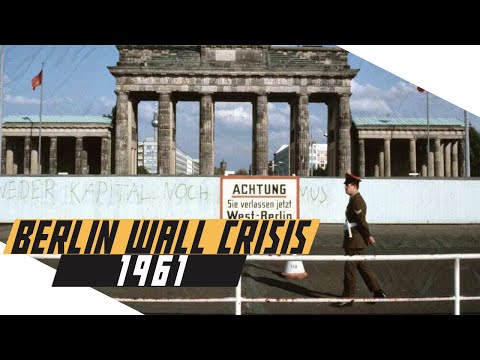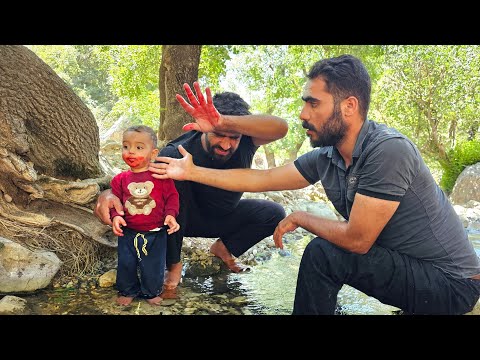How the Berlin Wall Started - Berlin Crisis 1961 - Cold War DOCUMENTARY

Fifteen years after Winston Churchill proclaimed that an Iron Curtain had descended across Eastern Europe, a crisis would emerge over Berlin, the city seen by many as the very center of the Cold War rivalry between East and West. The divided and contested city would see the rise of not just a metaphorical curtain but a physical one as well, dividing the city in two. The 1961 Berlin Crisis witnessed the pinnacle of the tense atmosphere which surrounded the still-occupied city, with not only a physical division but an infamous standoff at Checkpoint Charlie as the world stood on the brink. This crisis would see the construction of a barrier which would come to define the Cold War itself, the Berlin Wall. I'm your host David, and today we are going to look at the details
surrounding the leadup, stalemate, and aftermath of the 1961 Berlin Crisis. This is…the Cold War. We live in a busy world, always on the go, always something to do but I always make sure to make learning a key part of my day and what better way to do that than the sponsor of today’s video, a rising star in the streaming world, MagellanTV! MagellanTV is the highest rated documentary streaming app on Google Play and it offers the Best value of any Premium Documentary streaming service for both its price and especially its quality. And the reason is that MagellanTV is all about the drama of real life: the lives of ancient pharaohs, critical battles in world wars I and 2, soldiers who fought in the Civil War, the battles for control of the British Crown, the Norman conquest. Join us in watching Broken Arrows: The Lost Bombs of the Cold War, an episode looking at four different incidents where a nuclear bomb was lost and how close the world came to disaster. MagellanTV
has the largest and best collection of history shows anywhere! Not only are there no ads ever but your subscription always includes 4K. Click the link in the description and join us today! Post-war Germany was the most contentious spot on the European map throughout the early Cold War period. Split into four occupation zones, the occupied country was going through a process of denazification at the same time as a restructuring of its industry. However, the fallout from the increasing tensions between the Western allies and the Soviet Union, put any plans of unification on indefinite hold. The 1945 Potsdam Agreement had failed to find a peace agreement, instead defining rules for the occupation in expectation of a future peace treaty that would result in an independent and unified Germany. In September 1949, the French, British, and American occupation
zones were unified into the German Federal Republic, West Germany, under a Western aligned government with a market capitalist economy. One month later, the Soviet occupation zone was proclaimed the German Democratic Republic, a communist state aligned to the Soviet Union. The dividing lines were drawn through the middle of Europe, an iron curtain dividing East and West. However, deep in the heart of East Germany, one western exclave remained surrounded. The city of Berlin sat occupied by the Four Powers in a similar fashion to the rest of Germany, but under some more curious rules than the rest of East or West Germany. East Germany claimed East Berlin as an integral part of its territory and its capital, although to the Western Allies, East Berlin was still considered an occupied city. West Berlin on the
other hand, remained officially under the control of the Western Allies, even after the formation of West Germany and the end of the Allied occupation. Crucial for West Berlin were the transit corridors between West Germany and the city which allowed for the movement of people and goods. Although these transit corridors guaranteed movement, the agreement was between the Western Allies and the Soviet Union and not the Germans. Keep that important tidbit in mind as we move on.
To East Germany, and the Soviets as a whole, West Berlin posed a strategic and ideological threat to communism. The city stood as the last bastion of capitalism, preventing Soviet consolidation of their Eastern puppets. The Western allies, despite knowing the city was strategically indefensible, refused to retreat, understanding its symbolism as a beacon of democratic resistance in an ocean of totalitarianism. Initially, the Soviets had hoped to gain support through the city through the 1946
Berlin election, still riding high from their conquest and defeat of the Nazis a year earlier. However, their favored party suffered a major defeat in the city elections, checking any plans for future electoral victories across Germany. They knew they would fall short in an open contest. Therefore, their policy shifted and became one of conciliatory defense; trying to maintain what they had, and consolidate their gains. Consolidation however, meant striking at the shining beacon of capitalism in the East. In 1948, Josef Stalin attempted to force the west’s retreat from the city by blockading all access via road. In order to supply the stranded
people, the Western allies would need to open the road by military force. However, neither side truly wanted a war, which could easily prove to be deadlier than the one which had just finished. Stalin was hoping that the West, realizing their only options were to attack, starve, or withdraw, would choose the latter, handing over West Berlin without a fight. However, neither this aspiration, nor the threat of war would come to fruition, as the US Air Force, the Royal Air Force along with support from multiple other nations responded with the Berlin Airlift. This operation saw millions of tons of aid flown to cold and hungry Berliners, circumventing the blockade, and calling the Soviet’s military bluff, as they were unwilling to shoot down the supply runs.
Now, the next decade saw a lull in diplomatic activity regarding the city. Neither side wished to provoke a diplomatic incident, so they instead sat across their borders, eying each other suspiciously. East Berlin in this time became gradually more integrated into East Germany, becoming the country’s de facto capital and seat of government. At the same time the West also strengthened the political and economic ties between West Germany and their half of the occupied city. However, to prevent any commotion, both sides still kept their halves relatively
separate from the two Germanys. June of 1953 saw a small march by construction workers protesting increased work hours turn into mass demonstrations across East Germany that lasted up to a week in some areas. The East German Uprising was quickly broken up by Soviet armor, as a state of emergency was declared. The West, not seeking to provoke a wider emergency did nothing but look on.
Then, 10 years after the Airlift attempted to drive the West from the city, a new Premier, Nikita Khrushchev tried again. Fearing the handover of West Berlin to the West German government as well as the growing military integration of West Germany into NATO including the deployment of American nuclear weapons to West German soil, the Soviets issued an ultimatum on May 18th, 1958, demanding the full withdrawal of Western occupation forces from the city, and the creation of a demilitarized Free City of Berlin in its place. If the Western Allies did not withdraw, Khrushchev threatened to hand over control of the transit corridors between the FRG and West Berlin to the more belligerent East German government. The implication was of a possible return to the 1948 blockade which the West preferred to avoid, even if there were tentative logistical plans in place. But, with no agreement reached by the following year, Khrushchev would withdraw the ultimatum, agreeing instead to negotiation. In a meeting
between Nikitina and US President Eisenhower in 1959, the President made sure to emphasize the United States’ commitment to the city, but admitted that the US didn’t wish to see their occupation force remain in the city indefinitely. In the end, no agreement was reached, but both sides left feeling that future talks were possible. However, the nature of the Cold War, and its continuous political incidents, soon put a stop to any idea of a honeymoon over the city. In June of 1961, a summit of the former allied powers was held in neutral Vienna.
Here, Khrushchev pressed the issue of a treaty to reunite Germany as a neutral state, but largely under Communist influence. When that failed to produce any result, he then stated his intention to sign a separate peace treaty with the East German government, which he then felt, would be justified in claiming the whole of Berlin as its rightful territory, and all access to the city would be theirs to independently control, including the vital land and air corridors. France, the United Kingdom, and the US, obviously pushed back, but while doing this, President John F Kennedy made the accidental concession of US acceptance to a permanently divided Berlin. Whereas the future of the city had previously been held in contest, this negotiation subsequently justified the Soviet mindset that their occupied portion was indefinitely theirs, and not part of a larger united Berlin whose future needed to be settled. Given the mounting
issues that the divided city was causing, to at least diplomatically integrate the eastern half with the rest of East Germany was seen as the best way to isolate the Western half further. At the time, many Western analysts filled their days attempting to figure out Khrushchev’s motives for his policy on Berlin, and to be fair we are left doing the same thing in the present. Due to the limited access and sometimes non-existence of declassified records from this time, we are left an incomplete picture. Despite this, speculation abounds. A British memorandum from the Foreign Office from 1961 believed that it was the satellite state system that was forcing Khrushchev to press his hand, given that the West Berlin “escape hatch” was seen to be perpetually destabilizing East Germany, and thus weakening the Soviet hold over its most westward puppet state. To further complicate the situation, the memorandum goes on to theorize that, “Quite apart from the intrinsic Russian interest in stabilizing East Germany, Khrushchev is under direct pressure from Ulbricht and Gomulka to achieve this. He may also be under pressure from the other satellites. The stabilization of the East-German regime may well be regarded in the Communist world as one of the most important tests of the success of Khrushchev’s policy of ‘peaceful co-existence’.”
Others have speculated that Khrushchev’s brinksmanship approach to foreign affairs stemmed from his upbringing, where force and strength were seen as the best way to achieve goals. This may seem like a rather harsh assessment of Khrushchev’s methodology but the popularity of this theory may stem from people looking down on Khrushchev after his ouster from power as a peasant who had risen above his station. The Soviet Union may have declared itself a classless society, but as it matured, divisions reappeared. But, back to 1961. While both sides waited to see how the other would move, the summer months became filled with an uneasy tension. Although the prospect of nuclear war today should be considered unthinkable, the fear of it was very real in 1961. In fact, the US Deputy National Security Advisor, Carl Kaysen, even put together a study on the feasibility of a limited first-strike nuclear attack, different from the standard War Plan, the Single Integrated Operational Plan or SIOP, which called for an all-out strike against every target possible. Even though use of both the Kaysen Plan and the
SIOP were floated past president Kennedy, both were rejected on the grounds of mass casualties, false alarms, and limited reconnaissance. On August 12th 1961 a decision was made. Walter Ulbricht, the mayor of East Berlin, signed the order to erect a wall along the dividing line of the city's occupation zones and further to surround West Berlin behind closed doors. One of the main drivers of this decision was the major refugee crisis which had been happening in the city for over a decade. As the western half of Berlin recovered from the war, the East was left in comparative ruin and the economic disparity between the two halves of the city was growing. Citizens in East Berlin, including young people, were free to move west as they pleased.
An important note here is that free movement to the Western portion of the city was restricted to residents of East Berlin, which made the city into a magnet for other East Germans to try and get to. The result was enormous population movements, as East Germans tried to get to East Berlin and East Berliners fled to the West. It is estimated that somewhere between 2 and a half to 4 million refugees had through the city by 1961, devastating East German industry and agriculture, not to mention political stability. The diplomatic crisis that had started in 1958 over the status of Berlin had also seen the flood of refugees build into a torrent as people fled before something happened.
The days following August 12 saw a great mass of East German troops move into the city, sealing off the arteries of travel. Railways were dug up, roads demolished, and barriers topped with barbed wire were erected to not only divide Berlin inside the city, but completely surround the Western portion. With access to the city once again in jeopardy, and three Soviet army divisions placed adjacent to the access points, President Kennedy would make a show of force by calling up almost 150,000 reservists and national guardsmen to active duty by the end of August. Although it appears that neither side truly wanted, or possibly even believed in a war at this point, the nature of the Cold War demanded militaristic posturing. The wall itself rose rapidly, with barbed wire being replaced by concrete walls or hollow blocks.
Many people who lived on the border itself were evicted, and their units literally become part of the rising wall. In these buildings, ground floor windows were bricked up, and entrances sealed off. At all times of day, the area was patrolled by the police, military, and even local worker’s militias. Public transit was halted, and people on both sides were separated from their work, friends, and family. Some tried to cross anyways, escaping west. These moments of desperation often
ended in death for those that tried. On the 24th of August 1961, 11 days after the border closed, Günter Litfin became the first casualty of the border police, as he was shot while trying to swim across the Nordhafen river from East to West Berlin. Litfin was the first of over 140 people killed trying to escape over the Wall to the West. In the construction of the wall itself, the Soviet counterparts held nothing back. More than just a concrete barrier along the border,
the East German government built a series of defenses into their border itself to stop any potential defector. The area was filled with soft sand to show escapees' footprints, tank traps and ditches were positioned to prevent any vehicular escapes. A barbed wire fence ran along the wall, which would trigger an alarm if someone tried to climb it. These alarms were linked to watchtowers
which lined the middle section of the wall, and they held an unobstructed view of the whole area. Those that did try to escape, would be shot dead from above before they could reach the other side. The West, for their part, had no response. The barriers were set up in acknowledged East German
territory, the supply lines for West Berlin remain intact, and militarily, there was little to no threat of war. The Berlin Wall was a domestic matter and didn’t violate any of the standing treaty agreements in place. Thus, the West was all but limited to verbal protest. This lack of response quite possibly emboldened the Soviets, solidifying their position by building the wall. Whether a stronger response would’ve seen the halting of construction is debatable, but truth be told it is unlikely to have made any difference. However, the Wall also dealt the Soviets a serious PR blow. While the West came off as incapable of stopping the situation, many saw the wall as the USSR finally being forced to admit that their occupation of East Germany and its system were vastly unpopular, especially when compared to the West. Despite this, construction continued.
After construction, Soviet and East German border security continuously harassed military personnel and diplomats of the allied occupation forces moving through borders of the divided city. By the terms of the occupation which were still in place, Occupation personnel who were clearly identified were free to cross the border from West to East and back again. Many Allied soldiers took advantage of this, travelling to East Berlin for cultural and tourist events. On October 22nd,
the US Chief of Mission in West Berlin, E. Allan Lightner, Jr. was stopped in his car while crossing at Checkpoint Charlie in the American Sector. Since his car had occupation force license plates, this stop violated the 1945 Potsdam Agreements, and the US General, Lucius Clay, decided he had had enough. The following day, General Clay sent a diplomat through Checkpoint Charlie as bait, and when the car was stopped, US Military Police moved forward to escort him across the border, before returning to West Berlin, as the East German guards stood aside.
Over the next three days, both sides saw a major increase in military presence, each looking to test each other’s resolve. Each time, the Soviets would stop the car, and each time, American forces would escort the vehicle across, before returning into West Berlin. This type of fucking around however can only go so long before somebody finds out. On October 27,
in a rather serious turn of events, Soviet forces deployed 10 tanks to Checkpoint Charlie. This was actually a response to the tank that US forces had deployed as part of their escort efforts. Both sides now stood solid and unmoving, with tanks deployed little more than 100 meters apart from each other. With both sides now standing on the brink of a major international incident, pictures of the stand-off made worldwide headlines, foretelling of an inevitable war to come. However, as we all know, nuclear annihilation was not on the table for either
the Soviets or the United States, and so with quick negotiations, both sides withdrew from their mutually assured destruction. Khrushchev let his last demand for an Allied withdrawal from the city expire and the crisis came to an end. While West Berlin continued to be firmly in the sphere of influence of the West, the status of East Berlin was now at least tacitly secure, with East German citizens no longer able to flee and Soviet control recognized and unchallenged. Although this would be the final major incident over the city of Berlin itself, it certainly wouldn’t be the last time where the world’s superpowers stood on the brink of war. And as the doomsday clock counted down the minutes to midnight, the following year would see the closest humanity ever got to the end of the world, in the Cuban Missile Crisis. But that is a story for another time.
We hope you’ve enjoyed this episode and to make sure you don't miss our future work, please make sure you are subscribed to our channel and have built a wall of concrete and barbed wire, reinforced by watchtowers and landmines and patrolled by dogs so that you may keep the precious Bell Button secure. Please consider supporting us on Patreon at www.patreon.com/thecoldwar or through YouTube membership. We can be reached via email at thecoldwarchannel@gmail.com. This is the Cold War Channel and as we think about the Cold War, please remember that history is shades of gray and rarely black and white.
2023-02-15 01:57


